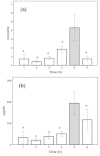Compartmentalization of lipid peroxidation in sepsis by multidrug-resistant gram-negative bacteria: experimental and clinical evidence
- PMID: 23324310
- PMCID: PMC4056356
- DOI: 10.1186/cc11930
Compartmentalization of lipid peroxidation in sepsis by multidrug-resistant gram-negative bacteria: experimental and clinical evidence
Abstract
Introduction: Recent evidence suggests a link between excess lipid peroxidation and specific organ failures in sepsis. No study has been performed in sepsis by multidrug-resistant (MDR) Gram-negative bacteria.
Methods: Lethal sepsis was induced in rats by the intraperitoneal injection of one MDR isolate of Pseudomonas aeruginosa. Produced malondialdehyde (MDA) was measured in tissues 5 hours after bacterial challenge with the thiobarbiturate assay followed by high-performance liquid chromatography (HPLC) analysis. Results were compared with those from a cohort of patients with ventilator-associated pneumonia (VAP) and sepsis by MDR Gram-negative bacteria. More precisely, serum MDA was measured on 7 consecutive days, and it was correlated with clinical characteristics.
Results: MDA of septic rats was greater in the liver, spleen, and aortic wall, and it was lower in the right kidney compared with sham operated-on animals. Findings were confirmed by the studied cohort. Circulating MDA was greater in patients with hepatic dysfunction and acute respiratory distress syndrome (ARDS) compared with patients without any organ failures. The opposite was found for patients with acute renal dysfunction. No differences were found between patients with ARDS without or with cardiovascular (CV) failure and patients without any organ failure. Serial measurements of MDA in serum of patients indicated that levels of MDA were greater in survivors of hepatic dysfunction and ARDS and lower in survivors of acute renal dysfunction.
Conclusions: Animal findings and results of human sepsis are complementary, and they suggest a compartmentalization of lipid peroxidation in systemic infections by MDR gram-negative bacteria.
Figures







Comment in
-
Lipid peroxidation in multidrug-resistant Gram-negative sepsis: translating science to the septic patient?Crit Care. 2013 Mar 1;17(2):120. doi: 10.1186/cc12505. Crit Care. 2013. PMID: 23448534 Free PMC article.
Similar articles
-
Lipid peroxidation in multidrug-resistant Gram-negative sepsis: translating science to the septic patient?Crit Care. 2013 Mar 1;17(2):120. doi: 10.1186/cc12505. Crit Care. 2013. PMID: 23448534 Free PMC article.
-
Immunomodulatory intervention in sepsis by multidrug-resistant Pseudomonas aeruginosa with thalidomide: an experimental study.BMC Infect Dis. 2005 Jun 26;5:51. doi: 10.1186/1471-2334-5-51. BMC Infect Dis. 2005. PMID: 15978135 Free PMC article.
-
The significance of oxidant/antioxidant balance for the pathogenesis of experimental sepsis by multidrug-resistant Pseudomonas aeruginosa.Prostaglandins Leukot Essent Fatty Acids. 2005 Jan;72(1):41-7. doi: 10.1016/j.plefa.2004.09.003. Prostaglandins Leukot Essent Fatty Acids. 2005. PMID: 15589398
-
Management of ventilator-associated pneumonia (VAP) caused by resistant gram-negative bacteria: which is the best strategy to treat?Expert Rev Respir Med. 2019 Aug;13(8):787-798. doi: 10.1080/17476348.2019.1632195. Epub 2019 Jun 24. Expert Rev Respir Med. 2019. PMID: 31210549 Review.
-
Cefiderocol: A Siderophore Cephalosporin with Activity Against Carbapenem-Resistant and Multidrug-Resistant Gram-Negative Bacilli.Drugs. 2019 Feb;79(3):271-289. doi: 10.1007/s40265-019-1055-2. Drugs. 2019. PMID: 30712199 Review.
Cited by
-
Sustained high serum malondialdehyde levels are associated with severity and mortality in septic patients.Crit Care. 2013 Dec 11;17(6):R290. doi: 10.1186/cc13155. Crit Care. 2013. PMID: 24326199 Free PMC article.
-
Advances in Biomarkers for Diagnosis and Treatment of ARDS.Diagnostics (Basel). 2023 Oct 24;13(21):3296. doi: 10.3390/diagnostics13213296. Diagnostics (Basel). 2023. PMID: 37958192 Free PMC article. Review.
-
The Emerging Role of Ferroptosis in Sepsis, Opportunity or Challenge?Infect Drug Resist. 2023 Aug 23;16:5551-5562. doi: 10.2147/IDR.S419993. eCollection 2023. Infect Drug Resist. 2023. PMID: 37641800 Free PMC article. Review.
-
Hydroxychloroquine attenuates sepsis-induced acute respiratory distress syndrome in rats.Ulus Travma Acil Cerrahi Derg. 2024 Jul;30(7):465-471. doi: 10.14744/tjtes.2024.98855. Ulus Travma Acil Cerrahi Derg. 2024. PMID: 38967533 Free PMC article.
-
Effect of bovine lactoferrin as a novel therapeutic agent in a rat model of sepsis-induced acute lung injury.AMB Express. 2019 Oct 31;9(1):177. doi: 10.1186/s13568-019-0900-8. AMB Express. 2019. PMID: 31673805 Free PMC article.
References
-
- Gelaim DP, de Bittencourt Pasqual MA, Comim CM, Grunwald MS, Ritter C, Damiani Tomasi C, Cascaes Alves S, Quevedo J, Dal-Pizzol F, Donsace Moreira JC. Serum heat-shock protein 70 levels, oxidant status, and mortality in sepsis. Shock. 2011;17:466–470. doi: 10.1097/SHK.0b013e31820fe704. - DOI - PubMed
Publication types
MeSH terms
Substances
LinkOut - more resources
Full Text Sources
Other Literature Sources
Medical

